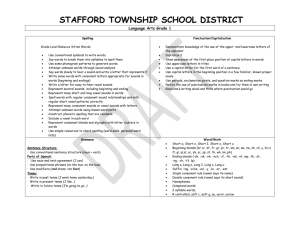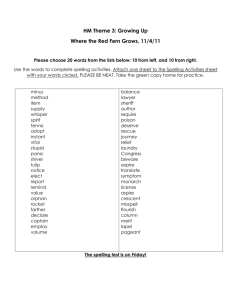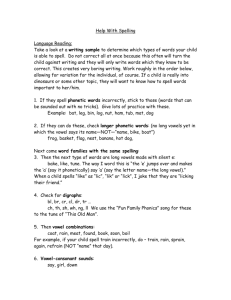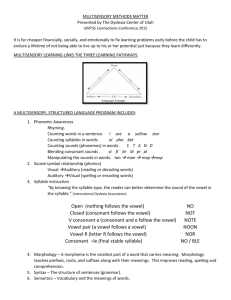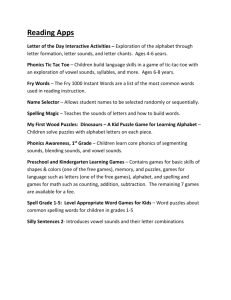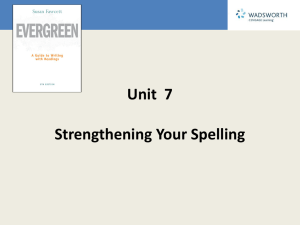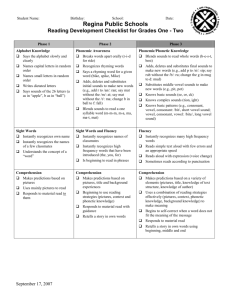Glossary
advertisement
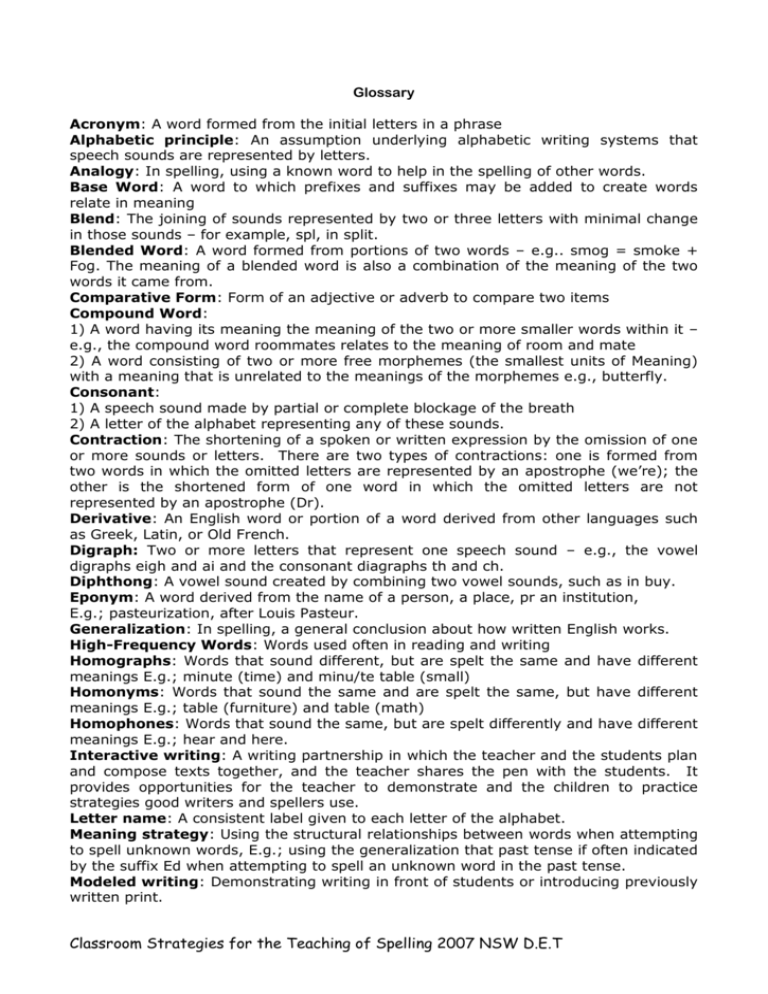
Glossary Acronym: A word formed from the initial letters in a phrase Alphabetic principle: An assumption underlying alphabetic writing systems that speech sounds are represented by letters. Analogy: In spelling, using a known word to help in the spelling of other words. Base Word: A word to which prefixes and suffixes may be added to create words relate in meaning Blend: The joining of sounds represented by two or three letters with minimal change in those sounds – for example, spl, in split. Blended Word: A word formed from portions of two words – e.g.. smog = smoke + Fog. The meaning of a blended word is also a combination of the meaning of the two words it came from. Comparative Form: Form of an adjective or adverb to compare two items Compound Word: 1) A word having its meaning the meaning of the two or more smaller words within it – e.g., the compound word roommates relates to the meaning of room and mate 2) A word consisting of two or more free morphemes (the smallest units of Meaning) with a meaning that is unrelated to the meanings of the morphemes e.g., butterfly. Consonant: 1) A speech sound made by partial or complete blockage of the breath 2) A letter of the alphabet representing any of these sounds. Contraction: The shortening of a spoken or written expression by the omission of one or more sounds or letters. There are two types of contractions: one is formed from two words in which the omitted letters are represented by an apostrophe (we’re); the other is the shortened form of one word in which the omitted letters are not represented by an apostrophe (Dr). Derivative: An English word or portion of a word derived from other languages such as Greek, Latin, or Old French. Digraph: Two or more letters that represent one speech sound – e.g., the vowel digraphs eigh and ai and the consonant diagraphs th and ch. Diphthong: A vowel sound created by combining two vowel sounds, such as in buy. Eponym: A word derived from the name of a person, a place, pr an institution, E.g.; pasteurization, after Louis Pasteur. Generalization: In spelling, a general conclusion about how written English works. High-Frequency Words: Words used often in reading and writing Homographs: Words that sound different, but are spelt the same and have different meanings E.g.; minute (time) and minu/te table (small) Homonyms: Words that sound the same and are spelt the same, but have different meanings E.g.; table (furniture) and table (math) Homophones: Words that sound the same, but are spelt differently and have different meanings E.g.; hear and here. Interactive writing: A writing partnership in which the teacher and the students plan and compose texts together, and the teacher shares the pen with the students. It provides opportunities for the teacher to demonstrate and the children to practice strategies good writers and spellers use. Letter name: A consistent label given to each letter of the alphabet. Meaning strategy: Using the structural relationships between words when attempting to spell unknown words, E.g.; using the generalization that past tense if often indicated by the suffix Ed when attempting to spell an unknown word in the past tense. Modeled writing: Demonstrating writing in front of students or introducing previously written print. Classroom Strategies for the Teaching of Spelling 2007 NSW D.E.T Onset: The consonant or consonants preceding the vowel in a syllable, E.g.; ple, /l/ in look. Phoneme: The smallest sound unit of spoken language. E.g.; the word telephone has seven Phonemes: /t/-/e/-/l/-/e/-/f/-/o/-/n/. Phonemic Awareness: Awareness of the separate sounds in words. Phonic Strategy: Using the sound-letter relationships in words when attempting to spell. Unknown words, E.g.; using the generalization that the /w/ sound is usually represented by the letter w when attempting to spell an unknown word with /w/ sound. Phonics: Letter-sound correspondences in a language. Phonological Awareness: The ability to hear and manipulate sound units in the language, such as syllables, onsets and rimes, and individual sounds in words (phonemes). Phonology: The study of speech sounds and their functions in language. Prefix: An affix attached before a base word that changes the meaning of the base word. Rime: The first vowel and any following consonants or vowels of a syllable E.g.; /ook/ in look. Schwa: In English, the midcentral vowel in an unstressed syllable. E.g.; /a/ in above, and /u/ in industry. Shared Writing: A writing partnership in which the students and the teacher together compose a piece of writing, then the teacher writes the piece. Unlike interactive writing, the pen is not shared between the students and the teacher, even though the students may suggest how the words should be spelt. Spelling Patterns: A group of letters representing a sound, including groups of letters, such as ould and ear, and diagraphs. Stress: The emphasis or degree of loudness placed on a syllable. Suffix: An affix attached to the end of a base word that changes the meaning or grammatical function of the word. Superlative Form: Form of an adjective or adverb used to compose more than two items. Syllable: The smallest unit of sequential speech sounds consisting of either a vowel sound or a vowel sound with one or more consonant sounds. Visual Strategy: Using the visual relationships between words when attempting to spell unfamiliar words, E.g.; knowing that the spelling pattern eigh represents the /ay/ sound in eight when attempting to spell the word weigh. Vowel: 1) A voiced speech sound made without stoppage or friction of the air flow as it passes through the vocal tract. 2) A letter of the alphabet representing any of these sounds: The letters A, E, I, O, U, Word Family: A group of words related in meaning. Words in a word family might be derived from the same base word and have different prefixes and/or suffixes added to it. E.g.; the word replays is derived from the base word play; the prefix re and the suffix s have been added to form a new word related in meaning to the base word, play. Compound words may also be part of a word family. E.g.; the words playground and playpen are related in meaning to the word play. Other word families may be based on derivatives. E.g.; the words photographer and telephoto are related in meaning to derivative photo. / / Used to indicate a sound. Classroom Strategies for the Teaching of Spelling 2007 NSW D.E.T


